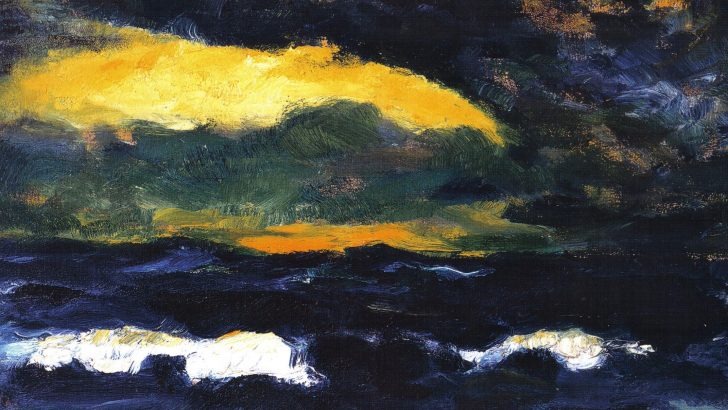Emil Nolde: “Colour is Life” : Beit Wing
curated by Janet McLean and Sean Rainbird, National Gallery of Ireland, with Keith Hartley, Scottish National Gallery of Modern Art
Exhibition runs until 10 June 2018.
The latest exhibition at the National Gallery presents a selection of paintings and other works from the long career of German artist Emil Nolde (1867-1956). His name until now has perhaps been an unfamiliar one, but some of the images in this show are of a kind that will long linger in the memory.
One of these is called ‘Light Breaking Through’, a cloud scope of grim storm through which the essential life-giving sun breaks through – an image very much in key with our recent meteorology.
The title might well be taken for the whole exhibition. Another painting, a portrait of a darkly dressed lawyer, with yellow notes of light reflecting off his glasses, but as if they light came from inside and represented the vivid interior imagination of an otherwise staid lawyer.
Yet in contest to this is an almost grey image of the docks at Copenhagen drawn contre jour which is also marvellously evocative. But the curators are right, for most of the making brilliant use of colour such as ‘Women in a Garden’ or ‘Large Poppies (Red, Red, Red)’.
The show is presented with great enthusiasm but for this review not all the images are a success.
Nolde painted a series on a 1914 expedition to the German corner of New Guinea (then called in true colonial style ‘Kaiser Wilhelm Land’).
These, aside from an image of a young man in the sea that almost prefigures Hockney (‘Swimming Native’), fail in their encounter with an alien culture with its own remarkable art traditions.
These were done at a time when other artists in Europe were much engaged with what was then called ‘Negro Art’. This is the only indication of the sort of German nationalism (which Nolde strongly espoused, along with a form of socialism) which rejects everything alien.
There are a series of images of Berlin night life, which are very strong, but one has to remind one’s self that they are done before the Great War, rather than in the Weimer years: here Nolde was a pioneer. It was perhaps these that led to him being included in the notorious government sponsored exhibition of ‘degenerate art’ – even though Nolde was in a way a supporter of the Nazis, from perhaps a distorted sense of German destiny.
One image, a painting of Adam and Eve (‘Paradise Lost’), is, it seems to me, inspired by an image done for Ernst Haeckel, the controversial evolutionist, of his idea of ‘the missing link’. Here Nolde presents a brutalised idea of the first man and woman in contrast, of course, to centuries of idealisation.
Here is one painting by Nolde that engages with contemporary philosophical ideas in the way few of the others do. His other pictures with religious themes also reflect the brutality of life rather than an expected spirituality
A very varied show then, but the visitor will rightly take away a memory not only of ‘Light Breaking Through’, ‘Women in a Garden’ and ‘Rain Over a Marsh’. Coming away one cannot but contrast Nolde’s often powerful images with the far tamer work that was then being painted in Ireland as ‘advanced’.


